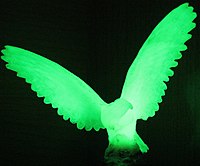
Photo from wikipedia
The conversion of low-energy light into photons of higher energy based on sensitized triplet-triplet annihilation (sTTA) upconversion is emerging as the most promising wavelength-shifting methodology because it operates efficiently at… Click to show full abstract
The conversion of low-energy light into photons of higher energy based on sensitized triplet-triplet annihilation (sTTA) upconversion is emerging as the most promising wavelength-shifting methodology because it operates efficiently at excitation powers as low as the solar irradiance. However, the production of solid-state upconverters suited for direct integration in devices is still an ongoing challenge owing to the difficulties concerning the organization of two complementary moieties, the triplet sensitizer, and the annihilator, which must interact efficiently. This problem is solved by fabricating porous fluorescent nanoparticles wherein the emitters are integrated into robust covalent architectures. These emitting porous aromatic framework (ePAF) nanoparticles allow intimate interaction with the included metallo-porphyrin as triplet sensitizers. Remarkably, the high concentration of framed chromophores ensures hopping-mediated triplet diffusion required for TTA, yet the low density of the framework promotes their high optical features without quenching effects, typical of the solid state. A green-to-blue photon upconversion yield as high as 15% is achieved: a record performance among annihilators in a condensed phase. Furthermore, the engineered ePAF architecture containing covalently linked sensitizers produces full-fledge solid-state bicomponent particles that behave as autonomous nanodevices.
Journal Title: Advanced materials
Year Published: 2019
Link to full text (if available)
Share on Social Media: Sign Up to like & get
recommendations!